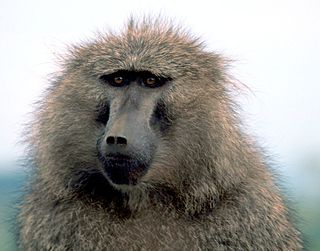
Primatology is the scientific study of non-human primates. It is a diverse discipline at the boundary between mammalogy and anthropology, and researchers can be found in academic departments of anatomy, anthropology, biology, medicine, psychology, veterinary sciences and zoology, as well as in animal sanctuaries, biomedical research facilities, museums and zoos. Primatologists study both living and extinct primates in their natural habitats and in laboratories by conducting field studies and experiments in order to understand aspects of their evolution and behavior.

Monthly Notices of the Royal Astronomical Society (MNRAS) is a peer-reviewed scientific journal covering research in astronomy and astrophysics. It has been in continuous existence since 1827 and publishes letters and papers reporting original research in relevant fields. Despite the name, the journal is no longer monthly, nor does it carry the notices of the Royal Astronomical Society. MNRAS publishes more articles per year than any other astronomy journal.
John Russell Napier, MRCS, LRCP, D.Sc. was a British primatologist, paleoanthropologist, and physician, who is notable for his work with Homo habilis and OH 7, as well as on human and primate hands/feet. During his life he was widely considered a leading authority on primate taxonomy, but is perhaps most famous to the general public for his research on Bigfoot.
The Primate Research Institute, Kyoto University is a Japanese research center for the study of primates. It was founded in 1967 by primatologists Kinji Imanishi and Junichiro Itani. The institute works toward understanding the biological, behavioral and socioecological aspects of primates, and the origin and evolution of humans. The institute is located in the city of Inuyama, Aichi Prefecture, which is about 150 km east of the main campus of Kyoto University. Through the Division of Biological Sciences of the Graduate School of Science of Kyoto University, the institute offers graduate programs leading to the Master of Science and Doctorate of Science degrees in the field of primatological science. Since 2013, the director of the institute is botanist Hirohisa Hirai.
Primates is a bimonthly peer-reviewed scientific journal of primatology, and an official journal of the Japan Monkey Center at Kyoto University. It publishes original papers that cover all aspects of the study of primates. The journal publishes original research articles, reviews, news and perspectives, and book reviews. It was established in 1957 by Kinji Imanishi. Although the first volume contained both articles in Japanese or English, subsequent volumes were published in English, thanks to a grant from the Rockefeller Foundation. It is now published by Springer and the current editor-in-chief is Masayuki Nakamichi.

The European Federation for Primatology (EFP) was founded on 17 December 1993. The seat of the Federation is Niederhausbergen (France).
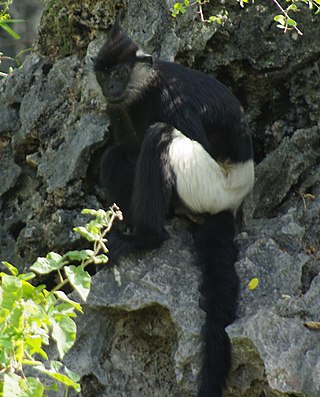
Delacour's langur or Delacour's lutung is a critically endangered species of Old World monkey endemic to northern Vietnam. It is named for French-American ornithologist Jean Théodore Delacour.
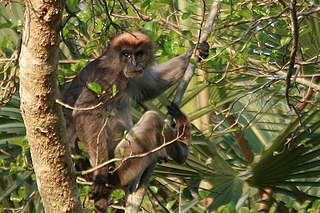
The Tana River red colobus, also called the eastern red colobus, is a highly endangered species of primate in the family Cercopithecidae. It is endemic to a narrow zone of gallery forest near the Tana River in southeastern Kenya.
Anthony R. Dickinson is a British academic, neuroscientist and a Scientific Advisor at the Beijing Genomics Institute. He specialises in brain development and incremental intelligence training.

The silky sifaka is a large lemur characterized by long, silky, white fur. It has a very restricted range in northeastern Madagascar, where it is known locally as the simpona. It is one of the rarest mammals on Earth. The silky sifaka is one of nine sifaka species, and one of four former subspecies of diademed sifaka (P. diadema). Studies in 2004 and 2007 compared external proportions, genetics, and craniodental anatomy supporting full species status, which has generally been accepted.

The gray-headed lemur, or gray-headed brown lemur, is a medium-sized primate, a cathemeral species of lemur in the family Lemuridae. Until a taxonomic revision in 2008, it was known as the white-collared brown lemur or white-collared lemur. It lives in south-eastern Madagascar. In 2005, satellite imagery estimates showed approximately 700 km2 (270 sq mi) of total remaining habitat within its geographic range. It is highly threatened by hunting and habitat loss, and was considered to be among the 25 most endangered primates in 2006–2008. It is currently listed as Critically Endangered by the International Union for Conservation of Nature (IUCN) due to a highly restricted range, and has been named one of "The World's 25 Most Endangered Primates."

The American Journal of Primatology is a monthly peer-reviewed scientific journal and the official journal of the American Society of Primatologists. It was established in 1981 and covers all areas of primatology, including the behavioral ecology, conservation biology, evolutionary biology, life history, demography, paleontology, physiology, endocrinology, genetics, molecular genetics, and psychobiology of non-human primates. Besides its regular issues, the journal publishes a yearly supplementary issue detailing the program of the society's annual meetings. The editor-in-chief is Karen Bales. The types of papers published are: original research papers, review articles, book reviews, commentaries, and plenary addresses.
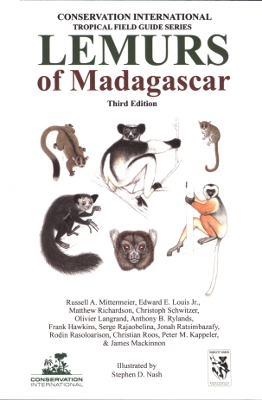
Lemurs of Madagascar is a 2010 reference work and field guide for the lemurs of Madagascar, giving descriptions and biogeographic data for the known species. The primary contributor is Russell Mittermeier, president of Conservation International, and the cover art and illustrations were drawn by Stephen D. Nash. Currently in its third edition, the book provides details about all known lemur species, general information about lemurs and their history, and also helps travelers identify species they may encounter. Four related pocket field guides have also been released, containing color illustrations of each species, miniature range maps, and species checklists.
The International Primatological Society (IPS) is a scientific, educational, and charitable organization focused on non-human primates. It encourages scientific research in all areas of study, facilitates international cooperation among researchers, and promotes primate conservation.

Toshisada Nishida was a Japanese primatologist who established one of the first long term chimpanzee field research sites. He was the first to discover that chimpanzees, instead of forming nuclear family-like arrangements, live a communal life with territorial boundaries. His discoveries of the medicinal use of plants by wild chimpanzees helped form the basis of the field of zoopharmacognosy.
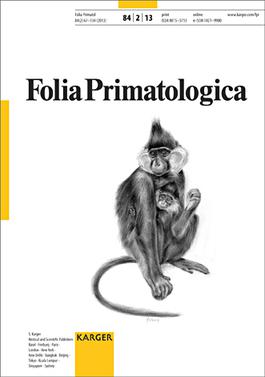
Folia Primatologica is an international peer-reviewed journal focusing on primatology, the study of monkeys, apes, lemurs, and other primates. Folia Primatologica was founded in 1963 by Adolph Hans Schultz, Helmut Hofer, Josef Biegert, and Dietrich Starck. Its start was preceded by two series of primatological monographs, both edited by the aforementioned founders, Primatologia , published in 1956, and Bibliotheca Primatologica, published in 1962.
Michael J. Owren was a Norwegian born American psychologist who contributed to the understanding of animal communication, the evolution of language, emotional communication, and vocal acoustics. His work focused on vocal phenomena in animals and humans. He pioneered digital spectral analysis techniques, first developed in speech science, for use in studies of animal communication. He studied primate vocalizations in terms of acoustics and communicative functions.
Jonah Ratsimbazafy is a Malagasy primatologist. In 2020, he was appointed President of the International Primatological Society.

Berthe Rakotosamimanana was a primatologist and palaeontologist from Madagascar.
Catherine (Cat) Hobaiter is a British-Lebanese primatologist focusing on social behaviour in wild chimpanzees and involved in long-term studies of chimpanzees in the Budongo Forest Reserve in Uganda and the MoyenBafing National Park in Guinea. She is particularly interested in the role gestures play in communication. She is a Reader at the University of St Andrews.












